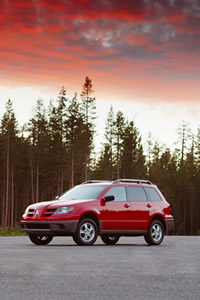 It's
more than a station wagon, but less than a true off-roader. It's
more than a station wagon, but less than a true off-roader.
It drives
like a car most of the time, but can take its lumps when the pavement runs out.
So how do we feel about Mitsubishi's new compact Outlander, being readied
for showrooms this Fall with a 2003 model year label and an attitude to boot?
Our introduction came in rural Virginia, where gently winding roads, green
fields with echos of historid battle, quaint little inns and 200-year-old villages
seemed the perfect backdrop for what Mitsubishi wanted us to learn. Imagine cruising
down gently curved roads, over narrow bridges and along old carriage paths with
every curve in the road yielding easily to a gentle touch on the steering wheel.
But that's getting ahead of ourselves a bit.
This
is a vehicle for those who thrive in Mitsubishi style -- the young, trendy, hip
driver image, "with it" enough to demand a punchy statement but smart
enough not to break the bank in the process. This could be for the daughter or
son getting ready for life beyond the limits of schooling, or a forever young
professional smart enough to want the best of a good bargain.
And Mitsubishi
seems determined to provide it.
CROWDED
COMPANY
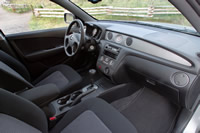 This
is the company's offering for an increasingly crowded segment
called "crossover," "cute ute," or in a
less complimentary fashion, "entry level." This
is the company's offering for an increasingly crowded segment
called "crossover," "cute ute," or in a
less complimentary fashion, "entry level."
That's
a term some might use for the base Outlander since at just under $18,000 it undercuts
most competitor prices. But forget any bottom feeder image.
This
is way beyond such limitations.
Initially I found the Outlander quite
attractive, a lower end offering with lots of eye candy pow and truly comfortable
amenities, although it edges toward average in some ways when out on the road.
And that, mind you, seems to be by design. The
only engine to power this small SUV is the same 16-valve, 2.4 liter, four cylinder
found in the Galant sedan. While it churns out a respectable 140 horsepower and
157 pound-feet of torque with oomph during initial acceleration, it drew constant
criticism at its summertime Virginia debut (admittedly in pre-production prototypes)
for a lack of guts in some demanding driving conditions.
But
despite repeated suggestions, Mitsubishi has no plans to put in anything heftier.
That was made clear by Gael O'Brien, vice president of corporate communications
and public affairs for Mitsubishi Motor Sales of America (MMSA), who staunchly
defended the decision not to step up engine power in the foreseeable future. The
company feels the Outlander is positioned "exactly where it should be,"
she said. And they don't want it to compete with the upcoming, larger and pricier
V-6 Endeavor SUV due out as a 2004.
FINDING
A LITTLE MORE POWER
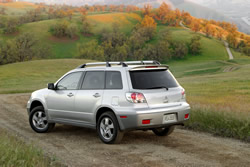 To
compensate, the only available Outlander transmission -- a four-speed
automatic in both front-wheel and all-wheel versions -- adds
a manual "Sportronic" shift mode. While it's undoubtedly
there for those who like to play but don't know, or don't want
to know, about stick shifts, I found it helped counteract one
of the vehicle's few noticeable flaws. To
compensate, the only available Outlander transmission -- a four-speed
automatic in both front-wheel and all-wheel versions -- adds
a manual "Sportronic" shift mode. While it's undoubtedly
there for those who like to play but don't know, or don't want
to know, about stick shifts, I found it helped counteract one
of the vehicle's few noticeable flaws.
When
climbing over the area's hilly terrain, the Outlander struggled less and simply
behaved better with the Sportronic mode engaged.
But
despite complaints about wimp power, it had a surprising amount of control and
stability for such a budget-priced entry. Digging into -- and out of -- sharp
curves at the top practical speed was easy thanks to the vehicle's taut independent
front and rear suspension and speed assist rack and pinion steering.
There
was almost no loose steering wheel play -- what manufacturers' call a dead area
-- to muddy up the road feel.
Mitsubishi
seems to have scored with styling that is bold yet somewhat understated, both
inside and out.
The
Outlander has a strong, aggressive face, with a blunted V-shape nose in the hood
anchored in front by the signature three-diamond logo.
It is sleeker and
more aerodynamic appearing than some competitors, namely the Subaru Forester,
redesigned for 2003 that barely inches into the SUV category heightwise. Having
driven the Forester earlier in its life, I noticed by comparison the Outlander's
distinctly more raised vehicle feel in addition to an obvious visibility advantage.
Storage, however, is smaller although ample enough to haul pieces of furniture.
The Japan-built Outlander shares platform and stiffened chassis with Mitsubishi's
sporty, entry-level Lancer sedan. It has the ride and feel of a car-based SUV,
but hasn't lost the sense of being a higher center of gravity vehicle. That was
evident one windy day during an extended driving test, and would have been more
so with luggage piled atop the sturdy roof rails.
EYE
APPEAL
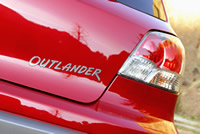 That
roof rack adds appeal to the Outlander's handsome exterior design, an option on
the economy LS but standard on the pricier XLS model. Overall lines are smooth
and supple with integrated head and tail lamps wrapping cleanly into the corners.
A touch of European influence shines in optional side-mounted oval turn indicator
lights. A slight running board makes getting in and out easier, and blends into
exterior lines when the doors are closed. That
roof rack adds appeal to the Outlander's handsome exterior design, an option on
the economy LS but standard on the pricier XLS model. Overall lines are smooth
and supple with integrated head and tail lamps wrapping cleanly into the corners.
A touch of European influence shines in optional side-mounted oval turn indicator
lights. A slight running board makes getting in and out easier, and blends into
exterior lines when the doors are closed.
A
slight spoiler tops the rear hatch-style door, extending the vehicle visually.
Accessing the flat rear storage floor is easy, as the deck's at about an average
woman's hip level. For added trunk room, the second row seating folds flat as
a whole or in 60 or 40 percent sections.
I've
never been able to relate cubic feet with the space needed to allow for comfort.
That's something I equate with carpet salespersons or real estate agents selling
houses. But despite stats of 96.1 cubic feet for passengers (60.3 cubic feet max
cargo space with the second row seats down), a body-on-leather test proved the
bolstered front seats felt comfortable and roomy while rear ones were more than
adequate. The front seat glide tracks extend back far enough to allow someone
truly tall to have maneuvering room. An adjustable steering wheel and seat height
controls help customize driving comfort.
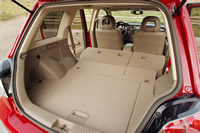 I
really liked the reclining second row seatbacks that go from
bolt upright to a relaxing incline, although presumably this
wouldn't be exaggerated while driving. But I had to remove the
unused mid-seat's headrest to gain a better sightline in the
rear view mirrors. I
really liked the reclining second row seatbacks that go from
bolt upright to a relaxing incline, although presumably this
wouldn't be exaggerated while driving. But I had to remove the
unused mid-seat's headrest to gain a better sightline in the
rear view mirrors.
Three-point
shoulder harnesses are standard on this five-passenger vehicle. One of the two
12-volt power accessory plugs is in the trunk area where small stow-away wells
hide under a flat cargo floor and a cargo cover, missing in the test model, would
lend a finishing touch.
The
Outlander's interior has two color palates, "grey" (the English spelling)
and "sandblast." The grey, with charcoal insets and some brushed metallic-look
edging, complements a silvery-toned XLS I tested and was one of the few times
I actually preferred that color on a vehicle.
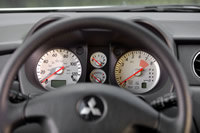 Nothing
inside appears cluttered, but everything seems just right. The instrument panel
is simple with a center-mounted quartz analog clock above the comfort and sound
system controls. Round gauges are set into hooded instrument cluster wells. And
the tachometer's red line is backlit in a catchy red check design, lending an
"I'm here" touch. Nothing
inside appears cluttered, but everything seems just right. The instrument panel
is simple with a center-mounted quartz analog clock above the comfort and sound
system controls. Round gauges are set into hooded instrument cluster wells. And
the tachometer's red line is backlit in a catchy red check design, lending an
"I'm here" touch.
LOTS OF AMENITIES
Mitsubishi has skillfully designed-in status while paring costs in both the
LS and XLS models. Despite the ho-hum powerplant, a left foot rest for balance
and above-door grab handles suggest a serious, power-boosted off-road capability.
While the XLS version's Sound & Sun option package has a well-balanced, optional
Infinity premium audio system, I couldn't adjust base or treble. Apparently what
you hear is what you get. Both models use front disc brakes. But rear drum brakes
peak through wide wheel cover gaps to diminish the overall look.
EPA
mileage estimates are 21 city and 26 highway for the front drive version, with
a loss of a mile each with all wheel drive. Options include Convenience, Appearance
and Luxury packages and cover a range of goodies from heated leather seating and
antilock brakes to side impact airbags, sunroof and 16-inch alloy wheels. A production
vehicle sticker that arrived just before press time put a loaded XLS all wheel
drive version at $24,470, including $580 in destination charges.
Overall,
the new Outlander seems a standout in a field that includes the established likes
of Ford Escape, Toyota RAV4 and Honda CR-V. It looked trendy and modern parked
near a similarly-sized Grand Vitara. During test drives it drew attention from
some young bikers and two men in a Chevy Blazer, and defied a guess at the price.
"That's
a Mitsubishi," said one surprised admirer. "I thought it was a Mercedes." |